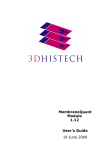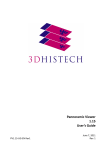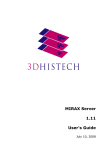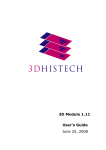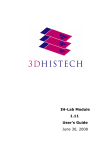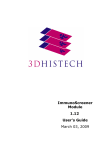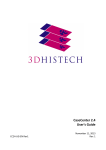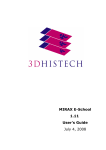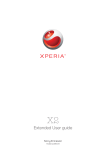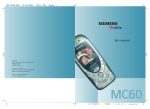Download FISHQuant Module 1.12 User's Guide June 11, 2009
Transcript
FISHQuant Module 1.12 User's Guide June 11, 2009 FISHQuant for MIRAX Viewer 1.12 User's Guide Contents Disclaimer.....................................................................................................................3 Font types and symbols..................................................................................................4 Terms and abbreviations.................................................................................................5 1 About FISH Analysis.....................................................................................................6 1.1 FISH Analysis in the MIRAX product family...............................................................6 1.2 Overview of FISH Analysis.....................................................................................7 1.2.1 FISHQuant algorithms...................................................................................7 1.2.2 MISP files.....................................................................................................7 1.2.3 Using a MISP file on other slides......................................................................7 2 Installing MIRAX Viewer and FISHQuant.........................................................................9 3 Working with FISH Analyzer........................................................................................10 3.1 Before you start..................................................................................................10 3.2 Creating an annotation for FISHQuant...................................................................10 3.3 Running the Algorithm on a Single Slide.................................................................11 3.4 Running Batch Process in FISHQuant.....................................................................15 4 Working with Measurement Visualization.......................................................................16 4.1 Creating a Histogram...........................................................................................16 4.2 Creating a Scatterplot..........................................................................................18 4.3 Creating a Gallery...............................................................................................19 4.4 Creating a Classification Gallery............................................................................21 Related documents.......................................................................................................23 Index..........................................................................................................................24 Appendix A FISH Analysis..............................................................................................26 A.1 Object-specific parameters...................................................................................26 A.2 Summing parameters for an area..........................................................................26 June 19, 2009 3DHISTECH Ltd. 2(26) FISHQuant for MIRAX Viewer 1.12 User's Guide Disclaimer Copyright All rights reserved. © 2001-2008 3DHISTECH Ltd. The following patents are pending for 3DHISTECH products: WO/2006/030326, P0700409 and 11/826,752. 3DHISTECH Ltd. is not liable for damage of whatever nature (including, but not limited to, general or specific damage, indirect damage, consequential damage or incidental damage, including the results of the analysis of the digitized slides, for example: change of health status related to erroneous diagnosis from the digitalized slide(s)) that stems from or is associated with use of Product, digitalized slides, quality of staining, quality of stained slides, quality of used method of staining. Certain legal systems do not allow the limitation or exclusion of accidental damage. This restriction therefore may not apply in your case. 3DHISTECH Ltd. assumes no responsibility for the functionality and fault-free condition of your "application programs" (Workflows, VBA macros, Commander scripts). CAUTION For research and education uses only, not for use in diagnostic procedures. This product has not been approved or cleared as a medical device by the U.S. Food and Drug Administration. The data and images obtained or viewed using this product are not intended for clinical or diagnostic use. Third-party disclaimer (LibTIFF - TIFF Library and Utilities) 3DHISTECH Ltd. is not liable for damage of whatever nature (including, but not limited to, general or specific damage, indirect damage, consequential damage or incidental damage, including damage resulting from lost profits, interruption of business, loss of business information, pecuniary loss or similar damage) that stems from or is associated with the incorporated part of this Product that is made by Silicon Graphics Inc. THE SOFTWARE IS PROVIDED "AS-IS" AND WITHOUT WARRANTY OF ANY KIND, EXPRESSED, IMPLIED OR OTHERWISE, INCLUDING WITHOUT LIMITATION, ANY WARRANTY OF MERCHANTABILITY OR FITNESS FOR A PARTICULAR PURPOSE. IN NO EVENT SHALL SAM LEFFLER OR SILICON GRAPHICS BE LIABLE FOR ANY SPECIAL, INCIDENTAL, INDIRECT OR CONSEQUENTIAL DAMAGES OF ANY KIND, OR ANY DAMAGES WHATSOEVER RESULTING FROM LOSS OF USE, DATA OR PROFITS, WHETHER OR NOT ADVISED OF THE POSSIBILITY OF DAMAGE, AND ON ANY THEORY OF LIABILITY, ARISING OUT OF OR IN CONNECTION WITH THE USE OR PERFORMANCE OF THIS SOFTWARE. Further information For the latest information http://www.3dhistech.com. June 19, 2009 on 3DHISTECH products 3DHISTECH Ltd. and services, visit 3(26) FISHQuant for MIRAX Viewer 1.12 User's Guide Font types and symbols Example Abbreviation or term that is explained in the section Terms and Abbreviations. Example Words or characters that appear on the screen. These include field names, screen titles, pushbuttons and menu names, paths or options. Keys on the keyboard. For example, function keys (such as F11) or the Ctrl+O key combination. Example Warning! Important! Tip! June 19, 2009 Cross-references to other documents. Indicates that you need an additional module to use the feature or that there are prerequisites for the task or that special care should be taken when using certain feature of the device. An important piece of information or a recommendation. The application will work if you choose not to follow the recommendation but its performance might be less than optimal. A suggestion about using the application in some other way or to some interesting purpose. 3DHISTECH Ltd. 4(26) FISHQuant for MIRAX Viewer 1.12 User's Guide Terms and abbreviations Annotation A particular detail of a digitized slide. FISHQuant can perform measurements on annotations. CSV format Comma separated value Digital slide Slide digitized with a MIRAX scanner microscope, for example MIRAX SCAN. Consists of an MRXS file and a folder with the same name as the MRXS file. Field In image analysis module: an annotation. In ImmunoScreener: a grid cell. Layer A group of cell compartments matching the same stain and size criteria. Measurement FISHQuant can perform two types of measurements: MISP • field-specific (related to the annotation) • object-specific MIRAX Imaging Segmentation Profile An image analysis segmentation and measuring algorithm is stored in a MISP file. MRXS MIRAX Slide File extension of a digitized MIRAX slide. Object A cell compartment (for example the FISH), cell or tissue that is relevant for the immunohistochemical analysis. Segmentation Identification of cells or cell compartments based on their different reaction to immunohistochemical staining. June 19, 2009 3DHISTECH Ltd. 5(26) FISHQuant for MIRAX Viewer 1.12 User's Guide 1 1 About FISH Analysis About FISH Analysis FISHQuant is an optional module for MIRAX Viewer. It allows you to detect and separate FISH spots on the virtual slides and digitalized with MIRAX microscopes. - FISH Analysis performs segmentation and measurements on MIRAX digital slides based on the colors of the spots. - Based on the applied FISH probe it can classify the cell nuclei. 1.1 FISH Analysis in the MIRAX product family The following picture shows how FISH and Measurement Visualization extend MIRAX Viewer and how they fit into the MIRAX product family. 1. Slides are digitized with MIRAX microscopes. A digitized slide consists of an MRXS file and a folder with the same name as the MRXS file. 2. Digitized slides are stored on a computer. You can also use a dedicated server (MIRAX Server) for storing the MIRAX slides. June 19, 2009 3DHISTECH Ltd. 6(26) FISHQuant for MIRAX Viewer 1.12 User's Guide 1 About FISH Analysis 3. Slides digitized with a MIRAX microscope can be viewed in MIRAX Viewer. If the slide is stored on a MIRAX Server, it is opened through the Teleconsultation module. Local slides are opened directly with MIRAX Viewer. 4. FISHQuant allows you to perform measurements on digital slides and to export the measurements in CSV format. 5. Measurement Visualization displays the FISHQuant data as a scatterplot, a histogram or a gallery. 6. Digital slides, including slides that store FISHQuant measurements, can be shared via PathoNet. They can also be used in E-School training and exam material. 1.2 Overview of FISH Analysis You can perform three types of tasks in FISHQuant: 1.2.1 • create algorithms based on your parameters and then run them on a slide or a set of slides • view the measurement results with the Measurement Visualization module, save the measurement annotations with the slide or export the measurement results to CSV file(s) • create a report based your saved measurements. FISHQuant algorithms FISHQuant allows you a FISH analysis setup application, which has a segmentation and a thresholding setup section. You can also change the score outlining color. The information needed for the algorithm is not saved on the slide but in a MIRAX Image Segmentation Profile (MISP) file, which can be used later to evaluate other annotations on the same slide or on other slides. 1.2.2 MISP files FISHQuant algorithms are saved in MISP files that store the following information about the algorithm: • segmentation (filters for noise reduction, segmentation and object separation) • classifications June 19, 2009 3DHISTECH Ltd. algorithm 7(26) FISHQuant for MIRAX Viewer 1.12 User's Guide 1.2.3 1 About FISH Analysis Using a MISP file on other slides You can reuse the MISP on other slides from the same batch (on slides that are from the same specimen) without modifications. You can also use the same algorithm on slides from other specimens with the same staining. You might need to adjust the profile to ensure that differences in the specimen or stain quality do not affect the result. June 19, 2009 3DHISTECH Ltd. 8(26) FISHQuant for MIRAX Viewer 1.12 User's Guide 2 2 Installing MIRAX Viewer and FISHQuant Installing MIRAX Viewer and FISHQuant 1. Start the MIRAX Viewer setup.exe file that you received on a MIRAX Viewer DVD or downloaded in a compressed file. 2. Follow the instructions in the installation wizard. 3. Start the application setup.exe file that you received on the application DVD or downloaded in a compressed file. 4. Follow the instructions in the installation wizard. June 19, 2009 3DHISTECH Ltd. 9(26) FISHQuant for MIRAX Viewer 1.12 User's Guide 3 3 Working with FISH Analyzer Working with FISH Analyzer 3.1 Before you start FISHQuant works on selected annotations. You will be able to run other algorithms on several annotations by selecting all the annotations that you need when you start the algorithm. Important! FISH Analysis algorithms require a significant amount of computer resources. The resource need and the speed of the Membrane Analysis evaluation depends on the size and the number of the measured annotations, and the quantity of detected objects. To ensure accurate results and to reduce computation time: • Make the training annotation as small as possible. The annotated areas should not be larger than 300x300 µm (1:1 magnification). • When you are creating a free-hand annotation, follow the outline of the area as closely as possible. • Membrane Analysis only works on slides to which you have write access. You may have only read permission to a slide if you access it through Teleconsultation and the host only gave you read permission, or if you access a slide stored on a network drive and you only have read, but not write permission to the drive. Tip! If you need measurements on the entire specimen, put an annotation on the slide to cover the entire specimen. 3.2 Creating an annotation for FISHQuant 1. Open the slide in MIRAX Viewer. For more information on how to open slides in MIRAX Viewer, see section Working with slides in MIRAX Viewer in the MIRAX Viewer 1.12 User's Guide. 2. Create the annotation on the area of your interest: • Select the annotation type (rectangle or free-hand) and cover the area with the annotation. June 19, 2009 3DHISTECH Ltd. 10(26) FISHQuant for MIRAX Viewer 1.12 User's Guide 3 Working with FISH Analyzer For information on navigating and zooming on the slide, see section Viewing slides in document Mirax Viewer 1.12 User's Manual. • In the Create or Edit Annotation window add a title to the annotation, enter a comment and determine the background color of the title and the outline color of the annotation. You can either select from predetermined colors or you can define custom colors. Only captions are exported to the CSV output file. Annotation descriptions are visible only in MIRAX Viewer. 3. Repeat step 2 for each area on which you want to run the algorithm. 3.3 Running the Algorithm on a Single Slide Open the slide in MIRAX Viewer. 1. In the main toolbar, click dules. June 19, 2009 and select FISHQuant from the Image Analysis Mo- 3DHISTECH Ltd. 11(26) FISHQuant for MIRAX Viewer 1.12 User's Guide 3 Working with FISH Analyzer 2. Select a FISH probe from the roll-down list. 3. If it's not automatical, choose the adequate channel name for the colors. 4. Select the annotation(s) you want to analyze in the Available window and move them to the Selected window. Also the whole slide can be selected to work with. 5. Select Profile Settings to define the parameters of the algorithm. June 19, 2009 3DHISTECH Ltd. 12(26) FISHQuant for MIRAX Viewer 1.12 User's Guide 3 Working with FISH Analyzer FISH Settings Setting or changing Profile Setup of the FISH algorithm. Channel Settings Specifying BRG color attributes . Annotation Selection Selecting annotation(s) for the measuring process. Process Annotation Area The algorithm will be executed only on the selected annotations. Process Whole Slide The algorithm will be executed on the whole digital slide area. Export settings The measurements will be exported to a CSV file that can be opened and edited further in Microsoft Excel. Important! FISHQuant is able to work with slides scanned in appropriate channel order (B-G-R) and with adequate channel name (blue/DAPI/Aqua; green/FITC; red/orange/rhodamine) only. 6. Click ProfileSetup and set the following attributes: Nucleus Threshold settings Specifying the limit values in DAPI channel; enabling Hole Filling with the DAPI mask if necessary. Extended Segmentation Especially for tissue samples. Emboss radius (1-100), Shape smooth iteration (1-100) and Maximal parts to merge (2-16) can be defined. June 19, 2009 3DHISTECH Ltd. 13(26) FISHQuant for MIRAX Viewer 1.12 User's Guide 3 Working with FISH Analyzer Spot Thresholding Specifying the limit values in FITC and Rhodamine channels. Nucleus filtering Nuclei can be filtered based on their shape factor and size. Spots filtering Spots can be filtered by size. Nuclei setup Setting the number of nuclei to measure and the average nucleus area for segmentation. Score Color Score-specific labelling can be defined. 7. Click OK to save settings and the form will be closed. Save Region measurements The measurements will be exported to a CSV file that can be opened and edited further in Microsoft Excel. Save Cumulative measurements The measurements will be exported to CSV files. A cumulative file will be created for each detected layer. Save to single CSV The measurements will be exported to a single CSV file. This file will contain all the parameters of the layers. 8. Launch the FISH Analysis algorithm by clicking Start. The process is fully automated, you only need to click Close when FISH Analysis has finished. FISH Analysis leaves open the slide. If more than one slide is open when you start FISHQuant, FISHQuant starts using the active one. June 19, 2009 3DHISTECH Ltd. 14(26) FISHQuant for MIRAX Viewer 1.12 User's Guide 3 Working with FISH Analyzer Tip! To view the existing annotations and existing measurements on the slide, click INFO in the slide toolbar and then select Show Annotations or Show HQ Measurements from the shortcut menu. 3.4 Running Batch Process in FISHQuant In Image Analysis Modules menu, you have the option to work with batch files. Select the slides you want FISHQuant to work with and specify the parameters for which they should be analyzed. Every slide needs to have the correct channel name and order, as mentioned above. June 19, 2009 3DHISTECH Ltd. 15(26) FISHQuant for MIRAX Viewer 1.12 User's Guide 4 4 Working with Measurement Visualization Working with Measurement Visualization The Measurement Visualization module for MIRAX Viewer creates a scatter plot or a histogram from the FISHQuant measurements. 4.1 Creating a Histogram 1. Click in the slide toolbar in the MIRAX Viewer. 2. Select the name of measurement from the drop-down menu that has been previously saved to the slide. 3. Select the annotations that you want to analyze. You can select all by checking the Select all option. 4. Select the object layer that you want to display from the Layer drop-down menu. 5. Select Histogram and the press Show button. 6. Set the parameters. If you enter new values into the text fields, press Enter to refresh the diagram. June 19, 2009 3DHISTECH Ltd. 16(26) FISHQuant for MIRAX Viewer 1.12 User's Guide 4 Working with Measurement Visualization Auto Refresh Automatically updates the histogram when you change the settings for the parent form. Statistics Overall shows the quantitative data of the objects. X Axis Offers various parameters for the X axis. When you export the results into a CSV file, there is an explanation for the abbreviations of the parameter names. Gate Chooses an interval within the examined range on X axis. Mode By using Gate function, the program either creates new histogram, new scatter plot, shows gallery or opens a new form where the user can save CSV files, but only in the selected interval. By not using Gate function, the program uses all the above mentioned features but for the whole data range. As the measurements run on digital slides, the perimeter and area sizes of the very small objects (appropriating the pixel-size) can show some inaccuracy. 7. [optional] To create a snapshot of the histogram, click Save. June 19, 2009 3DHISTECH Ltd. 17(26) FISHQuant for MIRAX Viewer 1.12 User's Guide 4.2 4 Working with Measurement Visualization Creating a Scatterplot 1. Click in the slide toolbar in the MIRAX Viewer. 2. Select the name of measurement, from the drop-down menu, that has been previously saved to the slide. 3. Select the annotations that you want to analyze. 4. Select the object layer that you want to display. 5. Select Scatter Plot and the press the Show button. 6. Set the parameters. If you enter new values into the text fields, press Enter to refresh the diagram. June 19, 2009 3DHISTECH Ltd. 18(26) FISHQuant for MIRAX Viewer 1.12 User's Guide 4 Working with Measurement Visualization Auto Refresh Automatically updates the histogram when you change the settings for the parent form. Statistics Overall it shows the quantitative data of the objects. X Axis Offers various parameters for the X axis. Y Axis Offers various parameters for the Y axis. Gate Chooses an interval within the examined range on X axis. You can position the scatter plot gates by clicking on the arrow. Mode By using Gate function, the program either creates new histogram, new scatter plot, shows gallery or opens a new form where the user can save CSV files, but only in the selected interval. By not using Gate function, the program uses all the above mentioned features, but for the whole data range. 7. [optional] To create a snapshot of the scatterplot, click Save. 4.3 Creating a Gallery 1. Click on the slide toolbar in the MIRAX Viewer. 2. Select the name of the measurement, from the drop-down menu, that has been previously saved to the slide. 3. Select the annotations that you want to analyze. 4. Select the object layer that you want to display. 5. Select Gallery and the press the Show button. 6. Set the parameters. June 19, 2009 3DHISTECH Ltd. 19(26) FISHQuant for MIRAX Viewer 1.12 User's Guide 4 Working with Measurement Visualization Auto Refresh Automatically updates the histogram when you change the settings for the parent form. Border size Sets the size of the image border. Zoom factor Sets the zooming rate of the images. You can determine the zooming value by entering the exact rate in the text field. Moving the cursor over an image an info box appears conveying all the necessary data regarding that image. 7. [optional] To export the gallery as an image, click Save. Tip! If you select an image in the gallery, it will be highlighted in the Scatter Plot as well. June 19, 2009 3DHISTECH Ltd. 20(26) FISHQuant for MIRAX Viewer 1.12 User's Guide 4.4 4 Working with Measurement Visualization Creating a Classification Gallery You can group your objects in accordance with their score values (the probe used on the objects). You can revalidate and rescore your object. On the right side panel, you can move cell nuclei from one group to the other. On the left panel, you can view the selected cell nuclei. June 19, 2009 Slideview Shows the selected slide. Outline Shows the group-specific outline. Boundary Shows the number of the detected objects. Export CSV Exports the measurements to a CSV file. Save to slide Saves the changes to the slides. Auto save Automatically saves all changes. Note, that it decelerates the program. Border size glide Increases / decreases the size of object borders in the right panel. Zoom factor glide Zooms in / out on the objects in the right panel. 3DHISTECH Ltd. 21(26) FISHQuant for MIRAX Viewer 1.12 User's Guide June 19, 2009 4 Working with Measurement Visualization Toggle mode You can select objects with the help of your mouse in the right panel. You can rescore objects using right-click. Field Parameters Shows the field specific parameters. Tooltip Moving cursor over an object shows the basic information of the given object. View You can select among normal, horizontal or vertical view of the objects in the right panel. 3DHISTECH Ltd. 22(26) FISHQuant for MIRAX Viewer 1.12 User's Guide 4 Working with Measurement Visualization Related documents MIRAX Viewer 1.12 User's Guide ImmunoScreener Module for MIRAX Viewer 1.12, User's Guide MIRAX SCAN User's Guide http://books.google.com/books?id=kvWKgG6iPXMC&dq June 19, 2009 3DHISTECH Ltd. 23(26) FISHQuant for MIRAX Viewer 1.12 User's Guide 4 Working with Measurement Visualization Index C L MISP...................................................5 computation time.................................9 Layer..................................................5 M June 19, 2009 S Segmentation......................................5 Segmentation Profile.............................5 3DHISTECH Ltd. 24(26) FISHQuant for MIRAX Viewer 1.12 User's Guide Appendix A A.1 FISH Analysis Object-specific parameters Parameter name A.2 4 Working with Measurement Visualization Description Area Area of the detected object in μm2 BInt B intensity of the detected object GInt G intensity of the detected object GrayInt Gray intensity of the detected object IF_C1 Integrated fluorescence in channel 1 IF_C2 Integrated fluorescence in channel 2 IF_C3 Integrated fluorescence in channel 3 LDia Longest diameter of the detected object in μm Peri Perimeter of the detected object in μm RInt R intensity of the detected object SDi Shortest diameter of the detected object in μm SF Shape factor of the detected object Summing parameters for an area Parameter name Description AvgPos0 Average positivity of negative Nuclei AvgPos+1 Average positivity of +1 Nuclei AvgPos+2 Average positivity of +2 Nuclei AvgPos+3 Average positivity of +3 Nuclei FA Overall annotation area in mm2 fNO NO/FA; frequency of detected objects per μm2 HSCORE MA Overall mask area in mm2: Total area of all detected objects in each layer. MA0 Mask area of negative Nuclei MA+1 Mask area of +1 Nuclei MA+2 Mask area of +2 Nuclei MA+3 Mask area of +3 Nuclei NO Number of detected objects: Total number of each detected object in each layer NO0 Number of negative Nuclei NO+1 Number of +1 Nuclei NO+2 Number of +2 Nuclei June 19, 2009 3DHISTECH Ltd. 25(26) FISHQuant for MIRAX Viewer 1.12 User's Guide 4 Working with Measurement Visualization NO+3 Number of +3 Nuclei rMA (MA/FA)*100; relative mask (object) area in % rMAPos ((‘MAO+1’ + ‘MAO+2’ + ‘MA+3’) / MA)*100 rNOPos ((‘NO+1’ + ‘NO+2’ + ‘NO+3’) / NO)*100 June 19, 2009 3DHISTECH Ltd. 26(26)


























